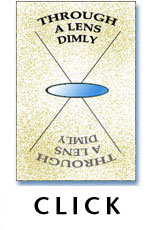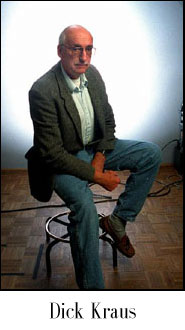|
|
|
|
|
|
THROUGH A LENS DIMLY CLICK Click...click...click, click, click..clickclickclickclick... How many times do you have to click the shutter before you know that you have THE shot; that elusive "Magic Moment?" It's tough these days, what with 2, 4 and even 8 gig digital cards in your camera that will hold hundreds of images. We tend to shoot everything that shows up in front of our lenses now that we have that kind of capacity. The result is that we have to cull through an inordinate amount of frames to find the one and only best image that tells the story. It was easier with film. When you only had 36 exposures, you tended to be a lot more selective before pushing the button. After all, you certainly didn't want to find yourself with two or three frames left to use when that "Magic Moment" did occur. Don't even get me started about what it was like when we were shooting with the 4 X 5 Speed Graphic. Given the amount of time and effort required to get another sheet of film in place, we really took a hard look before firing the shutter. I've known some real professional newspukes who could come back with the story telling shot on one 36 exposure roll and maybe still have 20 unexposed frames left.Then there were others who would dump 10, 20 or more rolls of film on the light box expecting the Photo Editor to pick the one that really worked. And, when asked to select that one shot himself, the hapless over-shooter couldn't make the choice. I was a Photo Editor for a couple of years and I hated it when that happened. It took away from my limited concentration when I was trying to finish the NY Times Crossword before I went home. And, it also bothered me that younger photographers who hadn't earned their stripes on the demands of the 4 X 5 Speed Graphic didn't have the shooting discipline of the older veterans. Nor did they care. Don't get me wrong. As I became more comfortable with shooting 35 mm, I certainly shot more than one or two shots per assignment. But, given the typical "head shots and real estate" type of assignments that prevailed at the paper, I would come back with two or three assignments on each roll. And that was on the 20 exposure rolls with which we were supplied back then. It could be accomplished if you had the Speed Graphic discipline. Before you made your first exposure, you would look over the scene and choose an angle that would offer the least distracting background. Then you would fire a shot so that you had "one in the bag" just in case you were called off that assignment because something more important came up. Then you would wait for a better expression or action or whatever and you would make another frame. Now, this is important. I said another frame, as in one more shot. Not a motor drive burst. Even if I had a motor drive on the camera, it would always be set to single frame. On assignments of some politician giving a press conference, there was no need of eight or ten or more shots that all looked the same. If I had the time to spend on that assignment, I might choose another angle just to vary my shots. Sometimes there would be a "magic moment" when the subject waxed passionate about his/her subject and his/her arms would gesture about and his/her eyebrows would arch and the face would contort and "CLICK." I knew that I had the shot and I could leave. Now it would be up to the editors to decide if that expression was in keeping with the tenor of the press conference. If not, there were always the more serene shots on the roll. We do have to be careful that our photos don't take one small moment out of context and have that represent the story. I remember covering a story, years ago, when a gubernatorial candidate made a campaign stop at a local Long Island fair. There were a bunch of photographers covering the speech and we were all concerned about the lack of expression on the man as he spoke. He was absolutely wooden and the few shots that we made at the start could just as well have been made of a corpse in a funeral home. We had our "in the bag" shot and were waiting; hoping that he would make some newsworthy gesture that would save our hides when our editors looked at our take on the light box and asked "Is that all there is?" Suddenly, the candidate raised an arm and pointed up to stress a point. CLICKITYCLICKITY-CLICKITYCLICK-CLICKCLICKCLACK.The clatter of motordrives going off almost drowned him out. We had our "magic moment. There were many assignments that taxed my creativity and my patience. Those were the times where I would have done my observation of the subject and the scene and decided on one or two angles and I would pop off a couple of exposures. But, something nagged at me that there was a better shot to be made. I would move around looking for a better angle. I would try a longer lens or a wider one. A couple of clicks and clacks later and I would still have that feeling that I didn't have that story telling shot. Where the Hell was it? I learned to listen to that damned voice in my head. Suddenly, there it would be, in my viewfinder. CLICKCLICK, and I absolutely knew that I had it. That's a great feeling. One morning I woke up to the aftermath of an overnight ice storm. All of Long Island was coated in a thick, transparent sheath of ice. I knew that this would likely be the lead story of the day, barring any disaster. The Day Photo Editor wasn't in yet so I grabbed a quick cup of coffee and started looking for the story telling shot while the morning light was at the perfect angle to charge the ice coating with a crystal-like effect. I clicked and I clacked at the ice coated tree branches and power lines. These shots were ok but something was missing. I needed a human element. The usual shots of my neighbors scraping and chopping the ice off their cars wouldn't show the incipient beauty that presented itself to the eye of the beholder. I tried close-ups of the ice coating on the trees. Nah! I used a long lens to shoot down the street showing the sagging, ice coated power lines glistening in the morning sun. Nah! I heard and felt the ice coated grass crunching under my boots. In those days, the prism housing on the old Nikon F's could be popped off the camera, allowing you to put the camera on the ground and you could focus and compose by looking down onto the groundglass that sat under the prism. Et Voila! There it was. Each blade of grass stood out with it's coating of crystal ice. Now I needed a human element. Forgive me. I did something that was considered a no-no in the industry. I grabbed my pre-school son, Douglas, and had his Mom get him suited up for the cold. I got him to squat on the ground amid the frozen grass and CLICKCLICK, I knew that I had it.
Oh, yeah. I changed my kid's name in the caption. My bad. But, I'll wager that I'm not the only news photographer who ever did that.
Dr. James Watson of the local Cold Spring Harbor Lab learned that he had won a share of the Nobel Prize for Science for his research in unlocking the secrets of the Double Helix of DNA.
Those moments are golden to press photographers.
|
||||||||




